Last Updated: 03/05/2023
National Surveillance of An. stephensi in Kenya using Molecular Methods
Objectives
- To determine presence or absence of An. stephensi circulating in Kenya,
- To discriminate between the different An. stephensi biological forms circulating in Kenya,
- To perform genomic analyses of the An. stephensi strains circulating in Kenya,
- To determine presence of plasmodium sporozoite in An stephensi mosquitoes.
U.S. President’s Malaria Initiative (PMI), United States
Abt Global, United States
Division of the National Malaria Program (DNMP), Kenya
Pan-African Mosquito Control Association (PAMCA), Kenya
Centers for Disease Control and Prevention (CDC), United States
World Health Organisation (WHO) – Kenya Country Office, Kenya
National Museums of Kenya (NMK), Kenya
Anopheles stephensi is an invasive malaria vector that is endemic to Asia, recently reported in the Horn of Africa countries including Djibouti (2012), Ethiopia, Sudan (2019), Somalia (2019) and most recently Nigeria (2020). This mosquito is a competent vector for both Plasmodium falciparum and P. vivax. It is a container breeder and therefore has the potential to propagate malaria transmission in rapidly urbanizing settings with poor drainage and disposal of waste containers. For this reason, the World Health Organization (WHO) has called on all countries to scale up surveillance efforts to be able to report invasion by this vector and institute appropriate and effective control mechanisms. In Kenya, the Division for National Malaria Program (DNMP) and its partners have been conducting entomological surveillance in all coastal and northern counties that are perceived to be at risk of An. stephensi invasion as well as in all the counties at risk of malaria. These efforts are supported by molecular surveillance of all unidentified Anopheles mosquitoes from other studies conducted by the Kenya Medical Research Institute (KEMRI) to try and identify An. stephensi. In this study we use Polymerase Chain Reaction (PCR) for preliminary detection of An. stephensi after identification using morphological keys and thereafter further confirmation through sequencing of the ITS2 region. With the detection of this vector in more regions in Africa, there is now an urgent need for stratified surveillance to describe its occurrence and distribution and practical steps towards control to prevent its further spread.
This is a cross-sectional study. Larval and adult mosquitoes are collected routinely from Coastal and Northern Kenya. Larvae are reared at sentinel lab sites and morphological identification is performed on the adult mosquitoes collected. Bioassays will be performed at sentinel labs. Polymerase Chain Reaction (PCR) is used for preliminary detection of An. stephensi after identification using morphological keys and thereafter further confirmation through amplicon sequencing of the ITS2 region and whole genome sequencing for genomic analyses. Sporozoite detection will be done using ELISA, targeting Plasmodium falciparum and vivax
Dec 2022 — Feb 2023
$40,000


